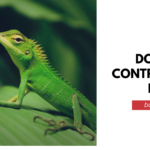
Pest control is an essential aspect of managing unwanted intruders in our homes. However, when it comes to lizards, a question arises: does pest control inadvertently harm these fascinating creatures that share our living spaces?
In this blog post, we will explore the relationship between pest control and lizards, shedding light on the potential impacts and offering insights into responsible pest management practices.
Now the Question is Does Pest Control Kill Lizards? Pest control methods can potentially harm or kill lizards if they come into direct contact with chemicals or become trapped. However, responsible pest control practices that prioritize prevention, exclusion, and targeted treatments can minimize harm to lizards while effectively managing pests.
Understanding Lizards
Lizards are remarkable creatures that play a vital role in the ecosystem. They help control insect populations, including pests that can transmit diseases or damage our property.
Common household lizards, such as geckos, often become unwelcome guests due to their presence indoors. While their sudden appearance may startle us, it is important to remember their beneficial role in maintaining a balanced ecosystem.
Types of Pest Control Methods
To combat pests, various pest control methods are employed, including chemical sprays and traps. While these methods effectively target unwanted pests, they can have unintended consequences for lizards.
Chemical sprays, for instance, may inadvertently harm lizards if they come into direct contact with the chemicals. Additionally, the use of traps could potentially disrupt lizard populations by removing their food sources or causing injury.
Impact of Pest Control on Lizards
Research indicates that some pest control methods can have indirect effects on lizards. For example, the elimination of pests could lead to a scarcity of food, reducing the lizards’ survival chances. Furthermore, the disruption of their natural habitats may force lizards to seek shelter in less suitable environments or even perish.
Responsible Pest Control Practices
Adopting responsible pest control practices can help strike a balance between managing pests and safeguarding lizards. Integrated pest management (IPM) offers a holistic approach that focuses on prevention, exclusion, and targeted treatments.
By implementing measures such as sealing cracks and gaps in homes, maintaining cleanliness, and using natural deterrents, homeowners can discourage pests while minimizing harm to lizards.
Balancing Pest Control and Lizard Conservation
It is crucial to consider the long-term benefits of having lizards around. Their presence offers natural pest control services, reducing the need for excessive chemical use.
To support lizard conservation, homeowners can provide suitable habitats by creating lizard-friendly environments with rocks, logs, and vegetation. By embracing the coexistence of lizards and managing pests responsibly, we contribute to the preservation of biodiversity.
Frequently Asked Questions:
Are there pest control products that specifically target lizards?
Yes, there are products on the market that are designed to repel lizards, such as sprays and electronic devices. However, their effectiveness can vary depending on factors like the species of lizard and the specific environment.
Is it safe to use pest control if I have lizards in my house?
Generally, yes. Most pest control methods are designed to be safe for non-target species. However, it’s always best to consult with a pest control professional to ensure that the methods being used will not unintentionally harm your resident lizards.
Do lizards indicate a pest problem in my home?
Lizards are often attracted to areas with a plentiful food source, which typically means insects. So, if you have a lot of lizards in your home, it might indicate that you have an underlying pest problem.
How can I prevent lizards from entering my house?
There are several steps you can take to make your home less appealing to lizards. These include sealing cracks and openings in walls and doors, keeping your house clean and free of insects (which are the primary food source for many lizards), and removing potential hiding places like piles of rocks or wood near your home.
Conclusion:
In the quest for a pest-free living environment, we must remember the delicate balance that exists between pest control and lizard conservation. While pest control methods may inadvertently harm lizards, responsible practices that prioritize prevention, exclusion, and targeted treatments can help minimize these negative impacts.
By adopting an approach that considers the well-being of both humans and the environment, we can create harmonious living spaces that accommodate both pest control needs and the presence of these remarkable creatures.
Let us strive for a world where lizards and humans can coexist peacefully, ensuring a healthier and more balanced ecosystem for all.

